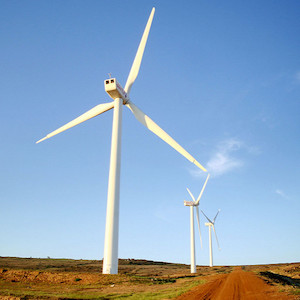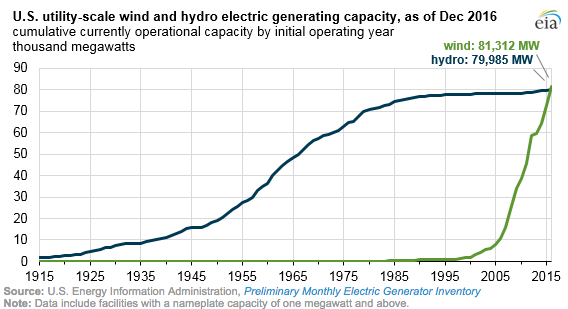 While the world was reeling and dealing with the outcome of the November 2016, an election won by a man who claims to value jobs over the environment and the climate, wind energy was quietly sneaking into fourth place as the source of electricity in America. In 2016, for the first time, wind energy became the leading source of renewable energy, surpassing hydroelectricity in total output.
While the world was reeling and dealing with the outcome of the November 2016, an election won by a man who claims to value jobs over the environment and the climate, wind energy was quietly sneaking into fourth place as the source of electricity in America. In 2016, for the first time, wind energy became the leading source of renewable energy, surpassing hydroelectricity in total output.
Here’s how the comparison to hydroelectric capacity looks in in graph form:
Wind capacity was increased by 8,203 megawatts in 2016, bringing the total capacity in the U.S. to 82,183 megawatts. 79% of that additional capacity was installed in the fourth quarter of the year during the time when Donald Trump was doing his own version of Sarah Palin’s “drill, baby, drill” charade. Despite Trump’s rhetoric about saving the nonexistent jobs of coal miners who have been systematically replaced by automation in their industry, the real job growth in the energy sector, even in rural areas, is in wind:
Over 100,000 American workers now manufacture, construct, and maintain the U.S. wind turbine fleet according to the U.S. Department of Energy. In total, wind supports more American jobs than nuclear, natural gas, coal, or hydroelectric power plants.
New growth in the fourth quarter of 2016, announced for the first time today, includes 6,478 MW, the second strongest quarter for U.S. wind power installations on record. For the year, wind developers added 8,203 MW of wind power capacity representing more than $13.8 billion in new investment. With 99 percent of wind projects located in rural areas, much of this investment is flowing to communities that need it most.
Rural and Rust Belt America are among the greatest beneficiaries of wind power development. Wind projects in these areas often become the largest contributors to the property tax base, helping to improve schools, roads and other public services. Of the $13.8 billion invested by the U.S. wind industry last year, $10.5 billion was invested in low-income counties.
In contrast, according to the Bureau of Labor statistics, coal mining employed only half that number of workers.
These sorts of statistics prove that new legislation introduced by Oregon’s Senator Jeff Merkley and Senator Bernie Sanders (I-VT), along with Senator Edward J. Markey (D-MA) and Senator Cory Booker (D-NJ) called the “100 by ’50 Act” not just liberal pie-in-the-sky dreaming. Their goal of supplying 100% of the country’s energy from renewable energy by 2050 is, in fact, quite achievable.
As climate change activist Bill McKibben told us in our podcast last week, renewable energy shouldn’t just be “pitched” as a job creator, it actually IS a job creator.
As renewable energy begins to quietly assume its rightful place as a major source of our nation’s energy, Donald Trump has appointed a climate change denier to head up the USEPA, put the former CEO of the largest fossil fuel company on the planet Rex Tillerson in as his Secretary of State, and is proposing ending NASA’s climate research programs, including the satellites that collect essential climate data. The resistance that has risen up since November of 2016 must continue to fight Trump’s fatalistic policies and actions like yesterday’s Climate March in Washington, D.C. and all around the country need to be just the first steps among many. And all of us should get behind the Merkley-Sanders “100 by ’50 Act” bill to make sure it gets as much attention as possible.
May the winds of resistance blow fierce and long. The future of our planet is at stake.
[CC photo credit: Warrenski | Flickr]




